An Effective GDP-LSTM and SDQL-Based Finite State Testing of GUI
Abstract
1. Introduction
1.1. Problem Statement
- None of the previous models focused on TC update requests that prompt incorrect results.
- The style characteristics of the GUI are considered as noise, which degrades the testing process.
- The existing techniques attained high time complexity due to the multiple GUI.
- The conventional methods struggle with the complex features of the GUI.
- The selection of appropriate ROI in GT is still difficult.
1.2. Objectives
- The GDP-LSTM and SDQL are established to distinguish the update and error of the GUI.
- An efficient MCS analysis is conducted to identify the suitable ROI.
- HP is carried out to handle the multiple GUI along with style characteristics.
- The DOM tree analysis deals with complex structures.
2. Related Literature Survey
3. Proposed Methodology
3.1. Test Case and GUI Extraction
3.2. ROI Selection
3.3. Hadoop Parallelization
| Algorithm 1: NE-GO-AC |
| Input: Mapped data Output: Reduced data |
| Begin Initialize population matrix , fitness , , , , , and For each ant do Initialize population Compute fitness function Update position, Estimate non-linear transition parameter, Measure probability, Select best candidate solution Implement End for Return reduced data End |
3.4. DOM Tree Construction
3.5. Attributes Extraction
3.6. GUI Testing
| Algorithm 2: GDP-LSTM |
| Input: |
| Output: |
| Begin Initialize , , , and For 1 to of attributes Evaluate PAF Perform Execute Compute End For Return End |
3.7. Deviation Analysis
4. Results and Discussion
4.1. Dataset Description
4.2. Performance Evaluation
4.3. Comparative Analysis
5. Conclusions
Author Contributions
Funding
Data Availability Statement
Conflicts of Interest
References
- Mishra, P. CT-GUI: A graphical user interface to perform calibration transfer for multivariate calibrations. Chemom. Intell. Lab. Syst. 2021, 214, 104338. [Google Scholar] [CrossRef]
- Ormeño, Y.I.; Panach, J.I.; Pastor, O. An empirical experiment of a usability requirements elicitation method to design GUIs based on interviews. Inf. Softw. Technol. 2023, 164, 107324. [Google Scholar] [CrossRef]
- Di Martino, S.; Fasolino, A.R.; Starace, L.L.L.; Tramontana, P. Comparing the effectiveness of capture and replay against automatic input generation for Android graphical user interface testing. Softw. Test. Verif. Reliab. 2021, 31, e1754. [Google Scholar] [CrossRef]
- Bahaweres, R.B.; Oktaviani, E.; Wardhani, L.K.; Hermadi, I.; Suroso, A.I.; Solihin, I.P.; Arkeman, Y. Behavior-driven development (BDD) Cucumber Katalon for Automation GUI testing case CURA and Swag Labs. In Proceedings of the 2nd International Conference on Informatics, Multimedia, Cyber, and Information System, ICIMCIS, Jakarta, Indonesia, 19–20 November 2020; pp. 87–92. [Google Scholar] [CrossRef]
- Walkinshaw, N. Improving Automated GUI Testing by Learning to Avoid Infeasible Tests. In Proceedings of the 2020 IEEE International Conference on Artificial Intelligence Testing, Oxford, UK, 3–6 August 2020; pp. 107–114. [Google Scholar] [CrossRef]
- Di Martino, S.; Fasolino, A.R.; Starace, L.L.L.; Tramontana, P. GUI testing of Android applications: Investigating the impact of the number of testers on different exploratory testing strategies. J. Softw. Evol. Process 2023, e2640. [Google Scholar] [CrossRef]
- Guo, W.; Shen, L.; Su, T.; Peng, X.; Xie, W. Improving Automated GUI Exploration of Android Apps via Static Dependency Analysis. In Proceedings of the 2020 IEEE International Conference on Software Maintenance and Evolution, Adelaide, SA, Australia, 28 September–2 October 2020; pp. 557–568. [Google Scholar] [CrossRef]
- Kilincceker, O.; Silistre, A.; Belli, F.; Challenger, M. Model-Based Ideal Testing of GUI Programs-Approach and Case Studies. IEEE Access 2021, 9, 68966–68984. [Google Scholar] [CrossRef]
- Silistre, A.; Kilincceker, O.; Belli, F.; Challenger, M.; Kardas, G. Models in Graphical User Interface Testing: Study Design. In Proceedings of the 2020 Turkish National Software Engineering Symposium, Istanbul, Turkey, 7–9 October 2020; pp. 1–6. [Google Scholar] [CrossRef]
- Doyle, J.; Saber, T.; Arcaini, P.; Ventresque, A. Improving mobile user interface testing with model driven monkey search. In Proceedings of the 2021 IEEE 14th International Conference on Software Testing, Verification and Validation Workshops, Porto de Galinhas, Brazil, 12–16 April 2021; pp. 138–145. [Google Scholar] [CrossRef]
- Pan, M.; Xu, T.; Pei, Y.; Li, Z.; Zhang, T.; Li, X. GUI-Guided Test Script Repair for Mobile Apps. IEEE Trans. Softw. Eng. 2022, 48, 910–929. [Google Scholar] [CrossRef]
- Yan, J.; Zhou, H.; Deng, X.; Wang, P.; Yan, R.; Yan, J.; Zhang, J. Efficient testing of GUI applications by event sequence reduction. Sci. Comput. Program. 2021, 201, 102522. [Google Scholar] [CrossRef]
- Pastor Ricós, F.; Slomp, A.; Marín, B.; Aho, P.; Vos, T.E.J. Distributed state model inference for scriptless GUI testing. J. Syst. Softw. 2023, 200, 111645. [Google Scholar] [CrossRef]
- Kumar, S.; Nitin; Yadav, M. Finite State GUI Testing with Test Case Prioritization Using Z-BES and GK-GRU. Appl. Sci. 2023, 13, 10569. [Google Scholar] [CrossRef]
- Kumar, S.; Nitin; Yadav, M. Finite state testing of graphical user interface using genetic algorithm. Int. J. Recent Innov. Trends Comput. Commun. 2023, 11, 282–287. [Google Scholar] [CrossRef]
- Ardito, L.; Coppola, R.; Leonardi, S.; Morisio, M.; Buy, U. Automated Test Selection for Android Apps Based on APK and Activity Classification. IEEE Access 2020, 8, 187648–187670. [Google Scholar] [CrossRef]
- Koroglu, Y.; Sen, A. Functional test generation from UI test scenarios using reinforcement learning for android applications. Softw. Test. Verif. Reliab. 2021, 31, e1752. [Google Scholar] [CrossRef]
- Coppola, R.; Morisio, M.; Torchiano, M.; Ardito, L. Scripted GUI testing of Android open-source apps: Evolution of test code and fragility causes. Empir. Softw. Eng. 2019, 24, 3205–3248. [Google Scholar] [CrossRef]
- Dataset. Available online: https://github.com/sd05031/Dataset_for_GUI_components (accessed on 7 January 2024).
- Xie, M.; Feng, S.; Xing, Z.; Chen, J.; Chen, C. UIED: A hybrid tool for GUI element detection. In Proceedings of the ESEC/FSE 2020 28th ACM Joint Meeting European Software Engineering Conference and Symposium on the Foundations of Software Engineering, Virtual, 8–13 November 2020; pp. 1655–1659. [Google Scholar] [CrossRef]
- Nguyen, V.; Le, B. RLTCP: A reinforcement learning approach to prioritizing automated user interface tests. Inf. Softw. Technol. 2021, 136, 106574. [Google Scholar] [CrossRef]
- White, T.D.; Fraser, G.; Brown, G.J. Improving random GUI testing with image-based widget detection. In Proceedings of the ISSTA 2019 28th ACM SIGSOFT International Symposium on Software Testing and Analysis, Beijing, China, 15–17 July 2019; pp. 307–317. [Google Scholar] [CrossRef]
- Xue, F.; Wu, J.; Zhang, T. Retracted: Visual Identification of Mobile App GUI Elements for Automated Robotic Testing. Comput. Intell. Neurosci. 2023, 2023, 9805091. [Google Scholar] [CrossRef]
- Zhu, P.; Li, Y.; Li, T.; Yang, W.; Xu, Y. GUI Widget Detection and Intent Generation via Image Understanding. IEEE Access 2021, 9, 160697–160707. [Google Scholar] [CrossRef]
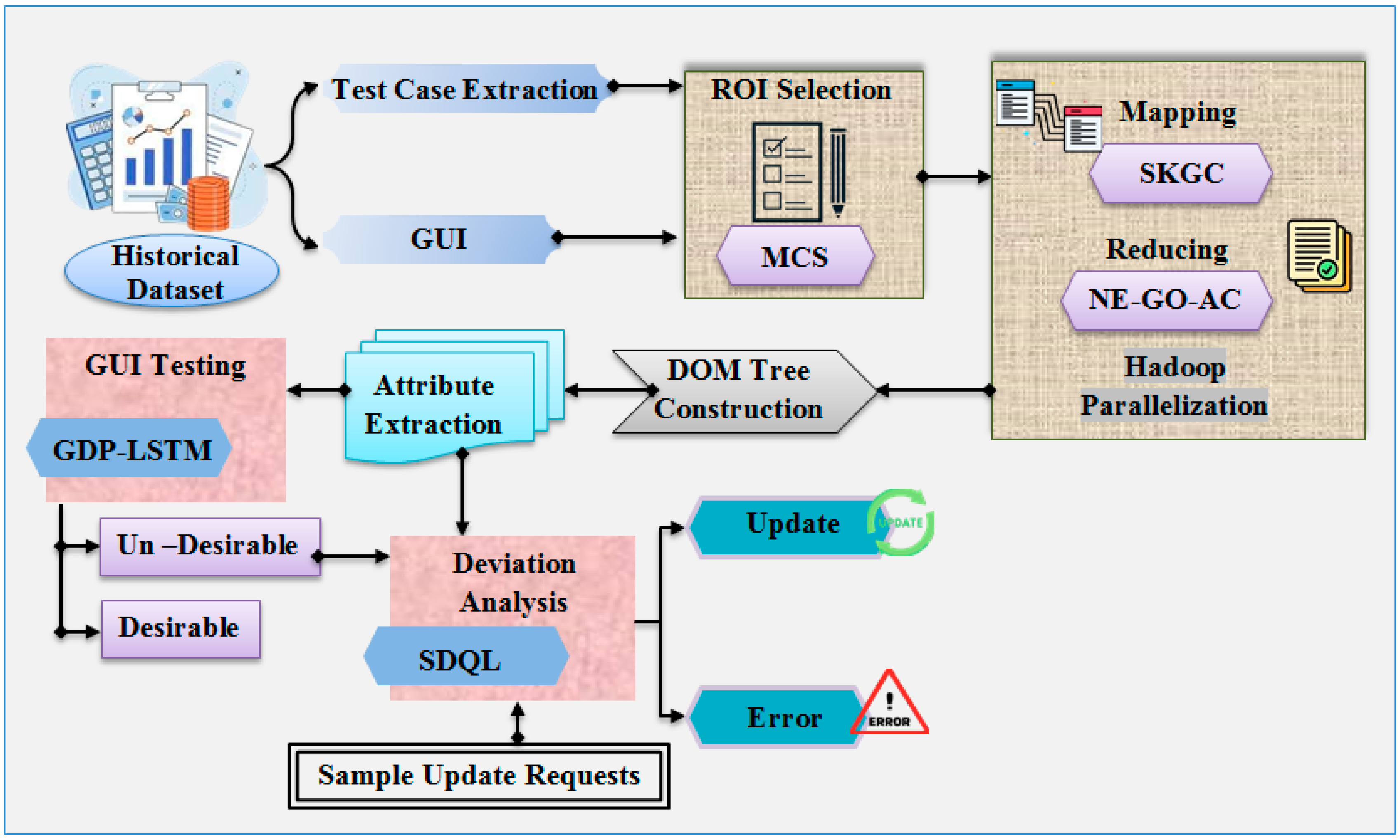
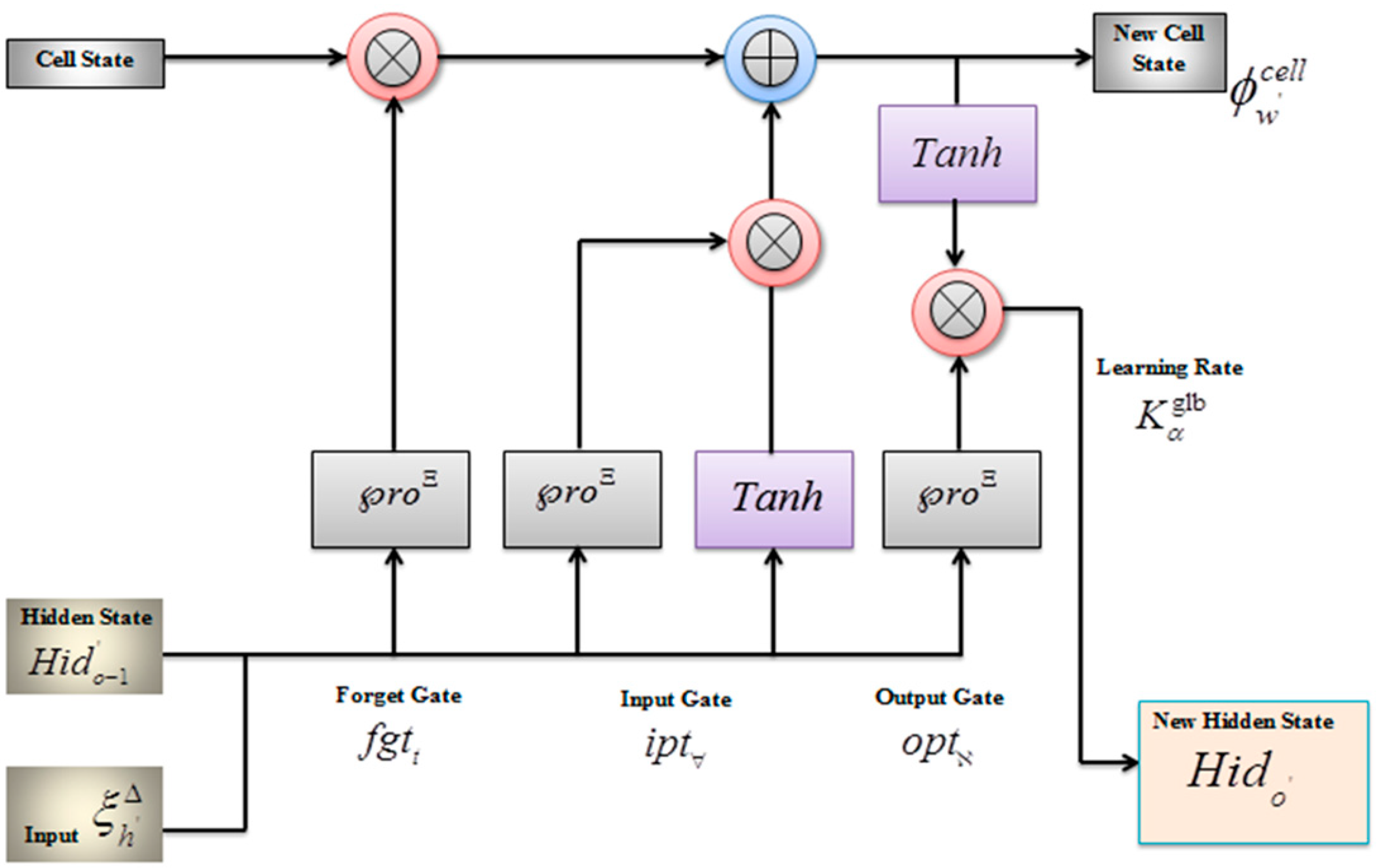
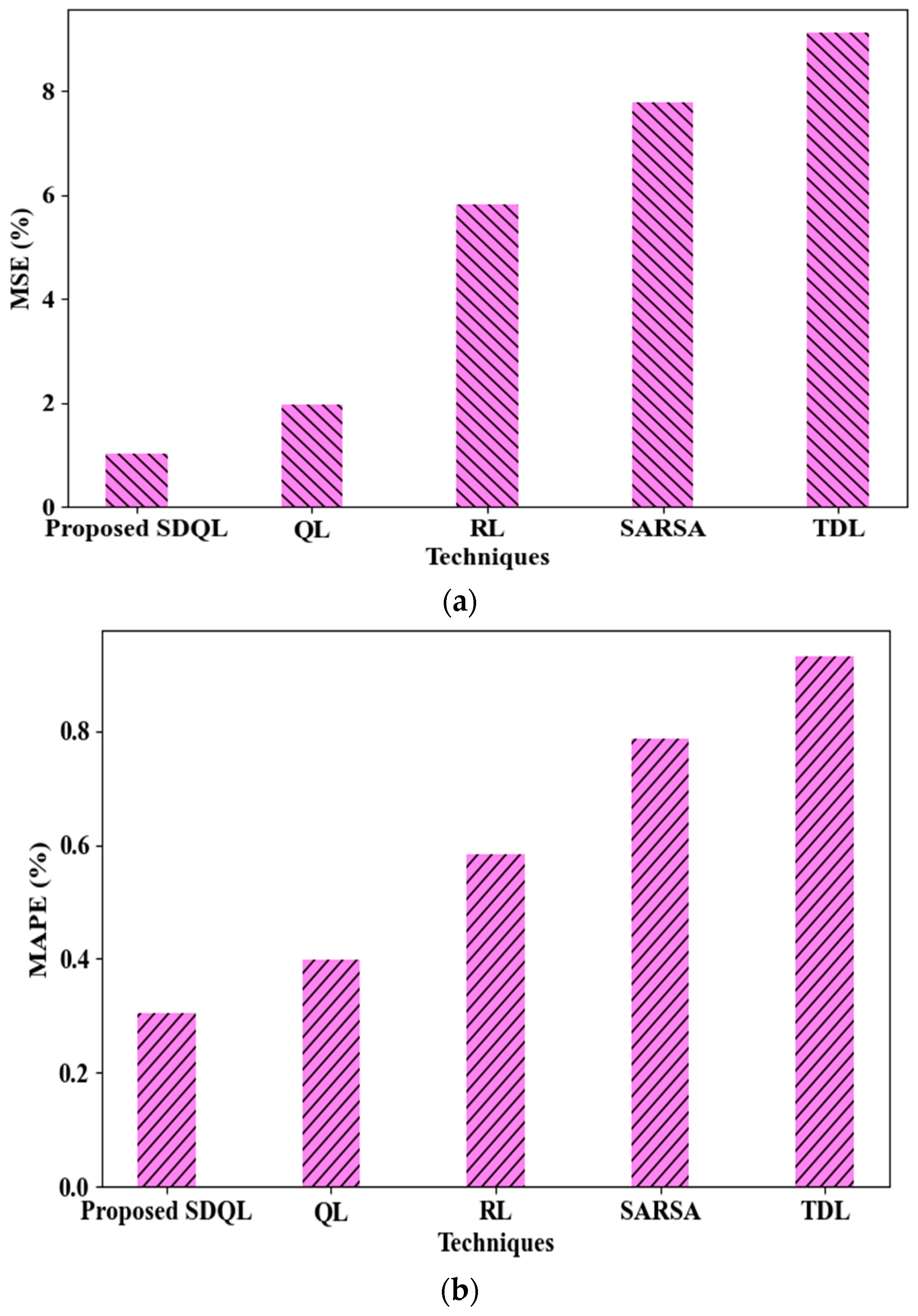
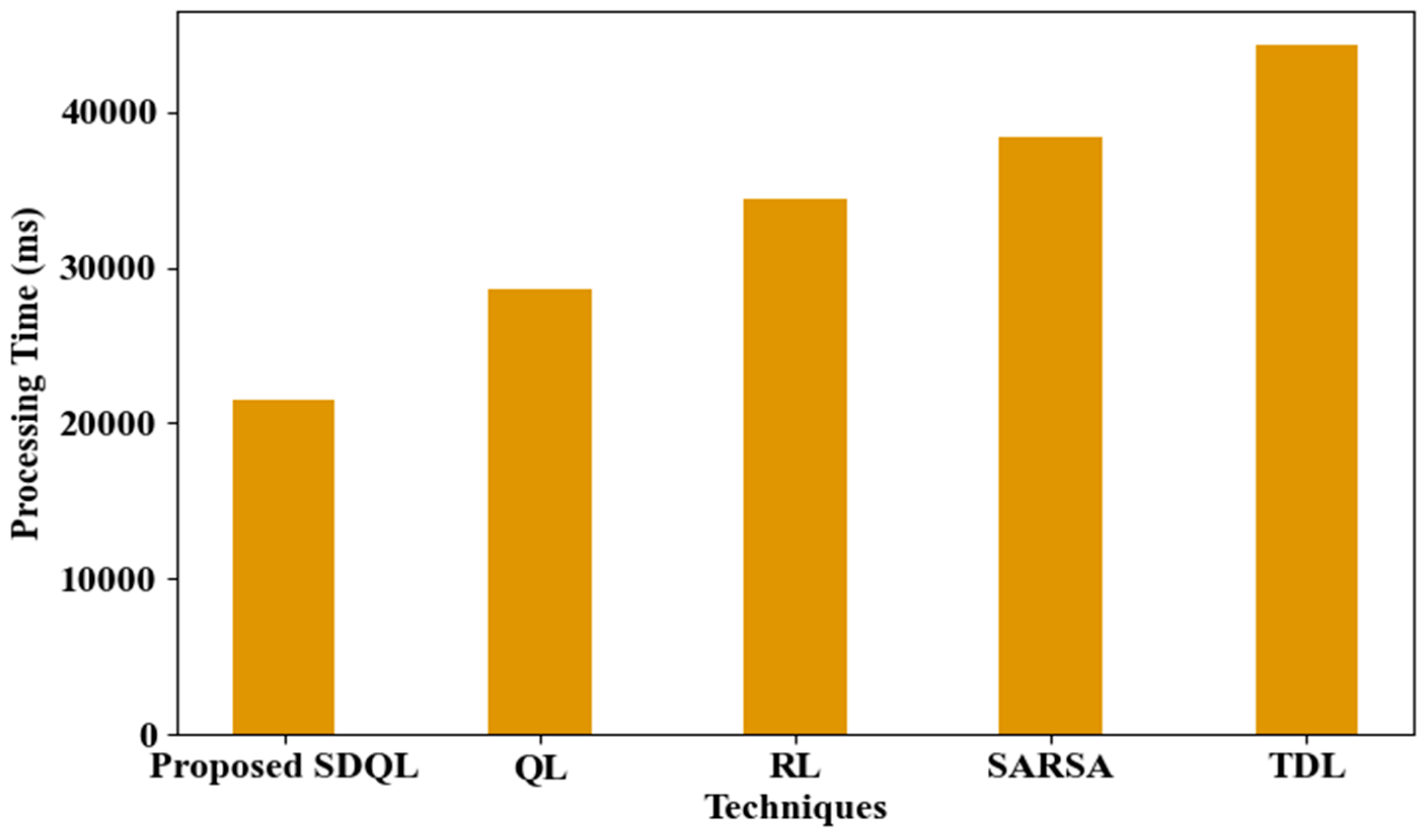
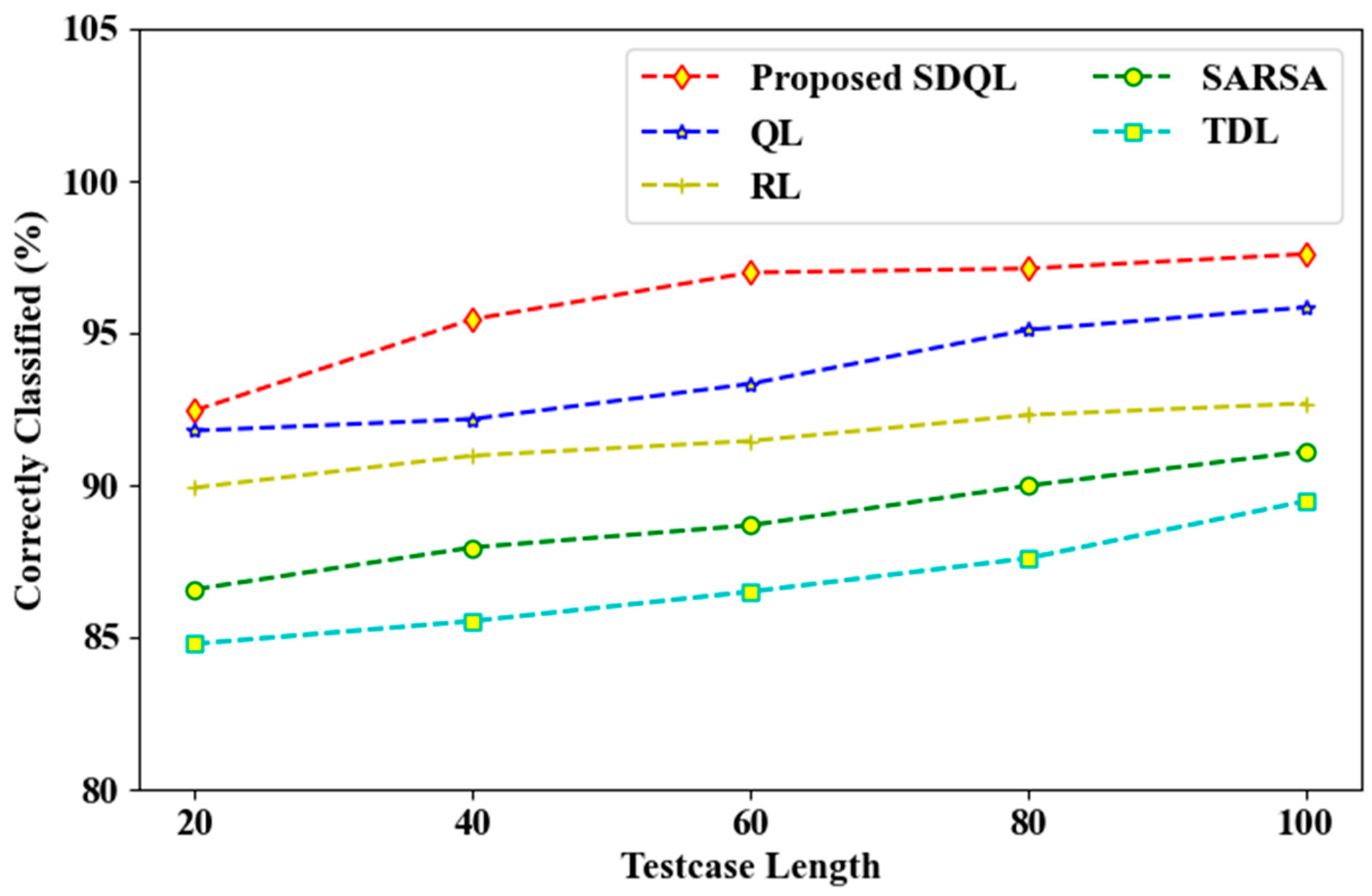

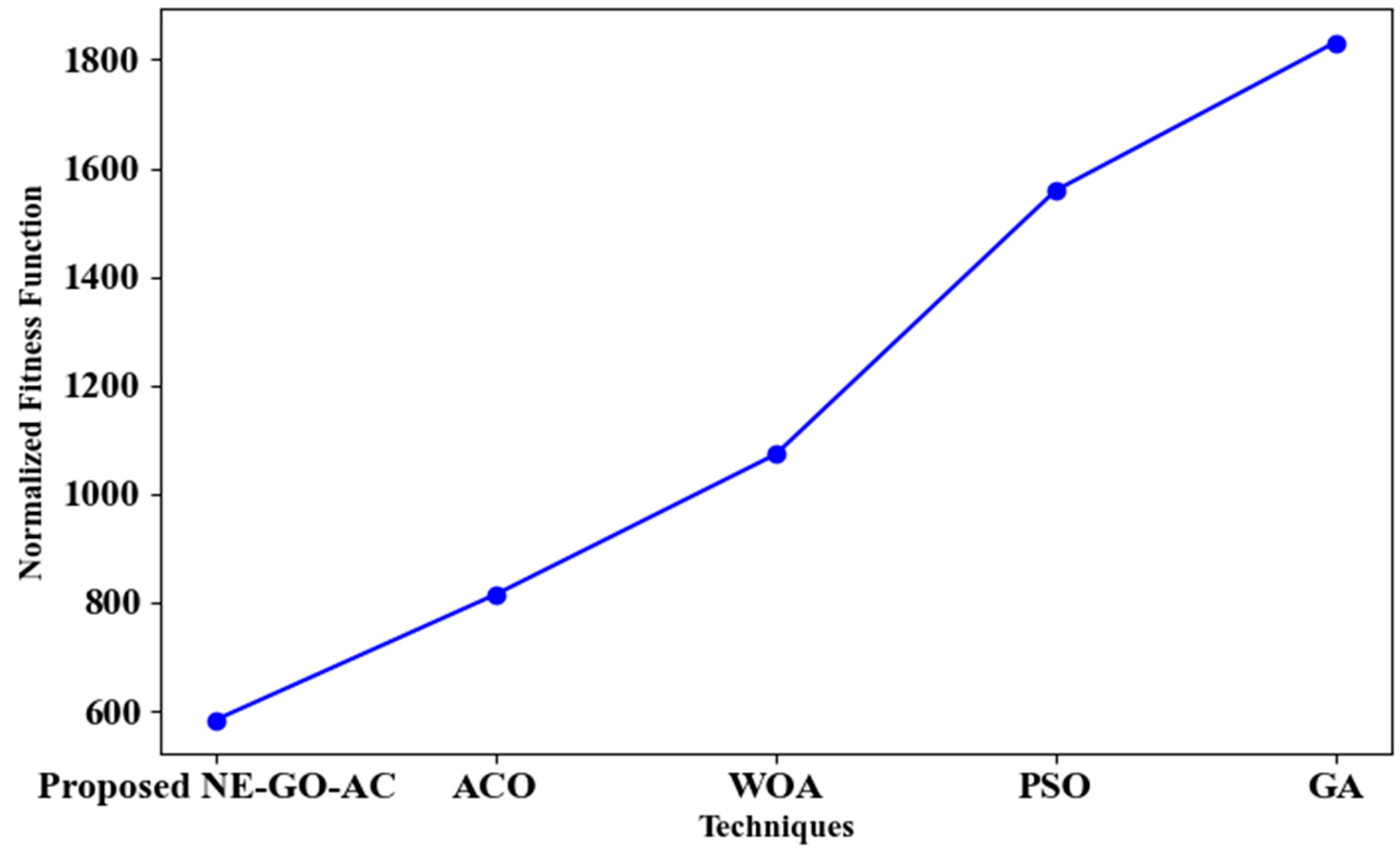
| Technique | Activity Coverage (%) |
|---|---|
| Proposed SDQL | 91.83 |
| QL | 86.45 |
| RL | 83.29 |
| SARSA | 81.78 |
| TDL | 77.05 |
| Methods | Clustering Time (ms) |
|---|---|
| Proposed SKGC | 56,942 |
| SC | 66,556 |
| HC | 85,863 |
| DBSCAN | 98,866 |
| KMC | 115,059 |
| Works | Techniques | PT (ms) | Precision (%) | Accuracy (%) | F-Measure (%) | TC vs. CC (%) |
|---|---|---|---|---|---|---|
| Proposed model | GDP-LSTM and SDQL | 21,456 | 98.98 | 98.89 | 99.21 | 92.45 |
| Xie et al. [20] | YOLO-v3 | 22,800 | - | - | 24 | - |
| Nguyen and Le [21] | RL | - | - | - | - | 74.29% |
| White et al. [22] | YOLO-v3 | - | 74 | - | - | - |
| Xue et al. [23] | YOLO-v3 | - | 86.63 | - | 84.53 | - |
| Zhu et al. [24] | LSTM | - | - | 81 | - | - |
Disclaimer/Publisher’s Note: The statements, opinions and data contained in all publications are solely those of the individual author(s) and contributor(s) and not of MDPI and/or the editor(s). MDPI and/or the editor(s) disclaim responsibility for any injury to people or property resulting from any ideas, methods, instructions or products referred to in the content. |
© 2024 by the authors. Licensee MDPI, Basel, Switzerland. This article is an open access article distributed under the terms and conditions of the Creative Commons Attribution (CC BY) license (https://creativecommons.org/licenses/by/4.0/).
Share and Cite
Kumar, S.; Nitin; Yadav, M. An Effective GDP-LSTM and SDQL-Based Finite State Testing of GUI. Appl. Sci. 2024, 14, 549. https://doi.org/10.3390/app14020549
Kumar S, Nitin, Yadav M. An Effective GDP-LSTM and SDQL-Based Finite State Testing of GUI. Applied Sciences. 2024; 14(2):549. https://doi.org/10.3390/app14020549
Chicago/Turabian StyleKumar, Sumit, Nitin, and Mitul Yadav. 2024. "An Effective GDP-LSTM and SDQL-Based Finite State Testing of GUI" Applied Sciences 14, no. 2: 549. https://doi.org/10.3390/app14020549
APA StyleKumar, S., Nitin, & Yadav, M. (2024). An Effective GDP-LSTM and SDQL-Based Finite State Testing of GUI. Applied Sciences, 14(2), 549. https://doi.org/10.3390/app14020549






